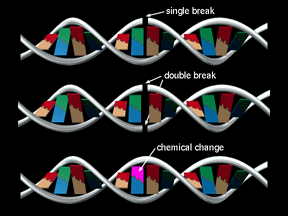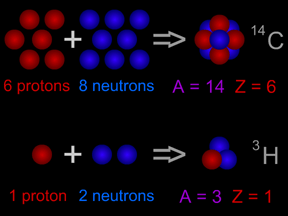Scientists study subatomic particles by examining the telltale trails, such as those shown here, their passage leaves behind in a bubble chamber. This image shows the first detection of a neutrino.
Click on image for full size
Argonne National Laboratory
Atomic Physics & Particle Physics
Did you know that a lot of what happens in space physics has to do with the interaction of really tiny particles? These particles like protons and electrons are so tiny that you can't even see them with your naked eye. That means you'd need special instruments to detect that they are even there.
The study of these tiny particles is called atomic physics and particle physics. Other particles have funny names like muon, neutrino, meson, and quark.
The "laws" of physics at atomic scales are so different from
those we see in our "normal" experiences that physicists had to invent
a whole new field in the early part of the 20th century to describe them. This field is called quantum mechanics.
You might also be interested in:

Text for this level has not been written yet. Please see the "Intermediate" text for this page if you want to learn about this topic. To get to the "Intermediate" text, click on the blue "Intermediate"
...more
The neutrino is an extremely light particle. (You definitely couldn't weigh one on your bathroom scale!) It also has no electric charge. Fusion reactions in the Sun produce neutrinos. By detecting these
...more
Whether or not a cell can repair itself after being damaged by radiation depends on the type of damage to the cell's DNA. Type of Damage Prospects for DNA Repair Single strand break in the DNA Can usually
...more
High frequency radiation or fast moving particles plow into a living cell with enough energy to knock electrons free from molecules that make up the cell. These molecules with missing electrons are called
...more
Did you know that a lot of what happens in space physics has to do with the interaction of really tiny particles? These particles like protons and electrons are so tiny that you can't even see them with
...more
One way scientists measure the size of something is by its mass. Mass is sort of like weight. Scientists can even measure very, very tiny things like atoms. One measure of the size of an atom is its "atomic
...more
Every atom has a nucleus. The nucleus has protons and neutrons in it. Scientists have a special name for the number of protons in an atom. They call it the "atomic number". There are almost 100 different
...more












